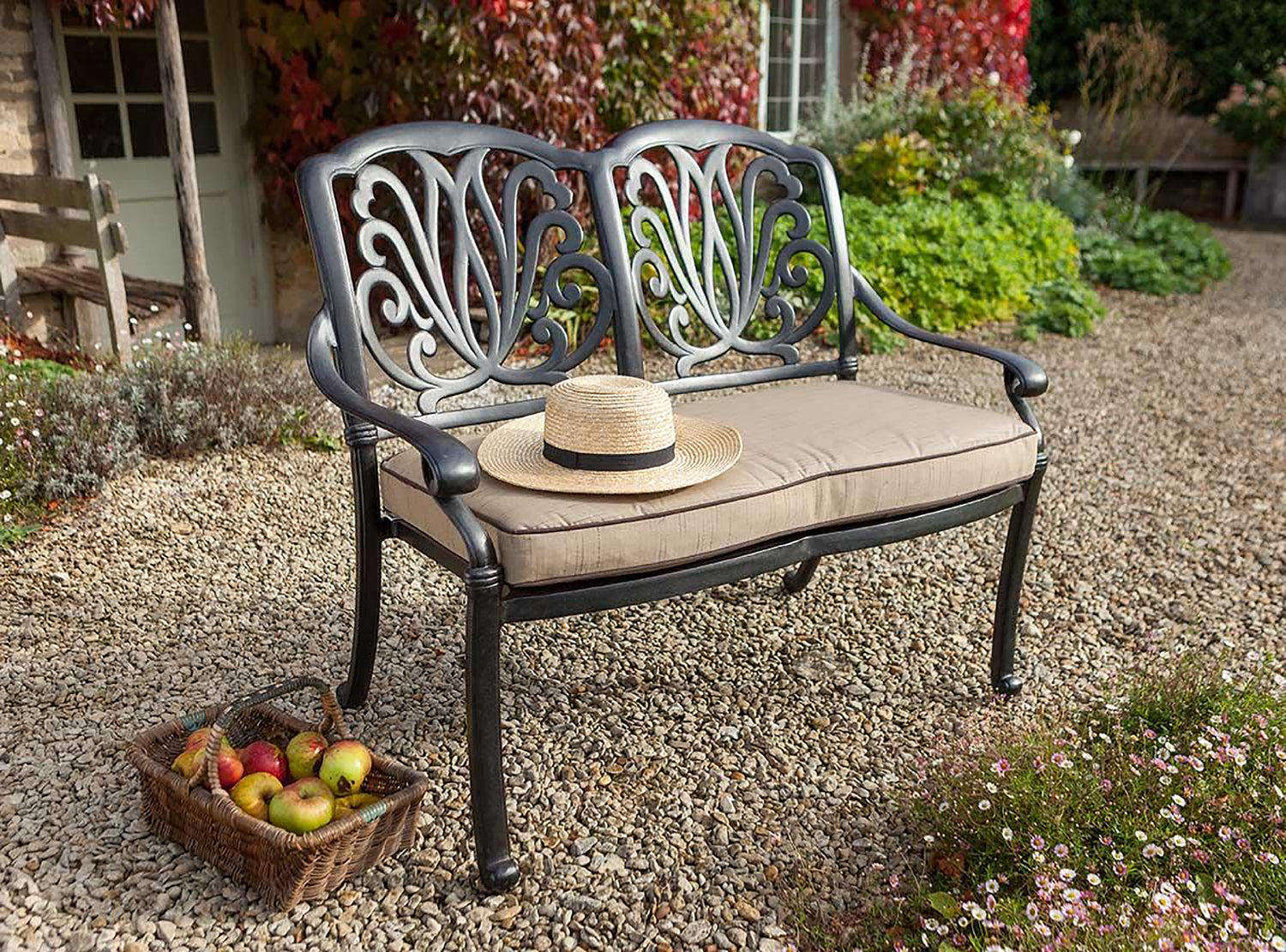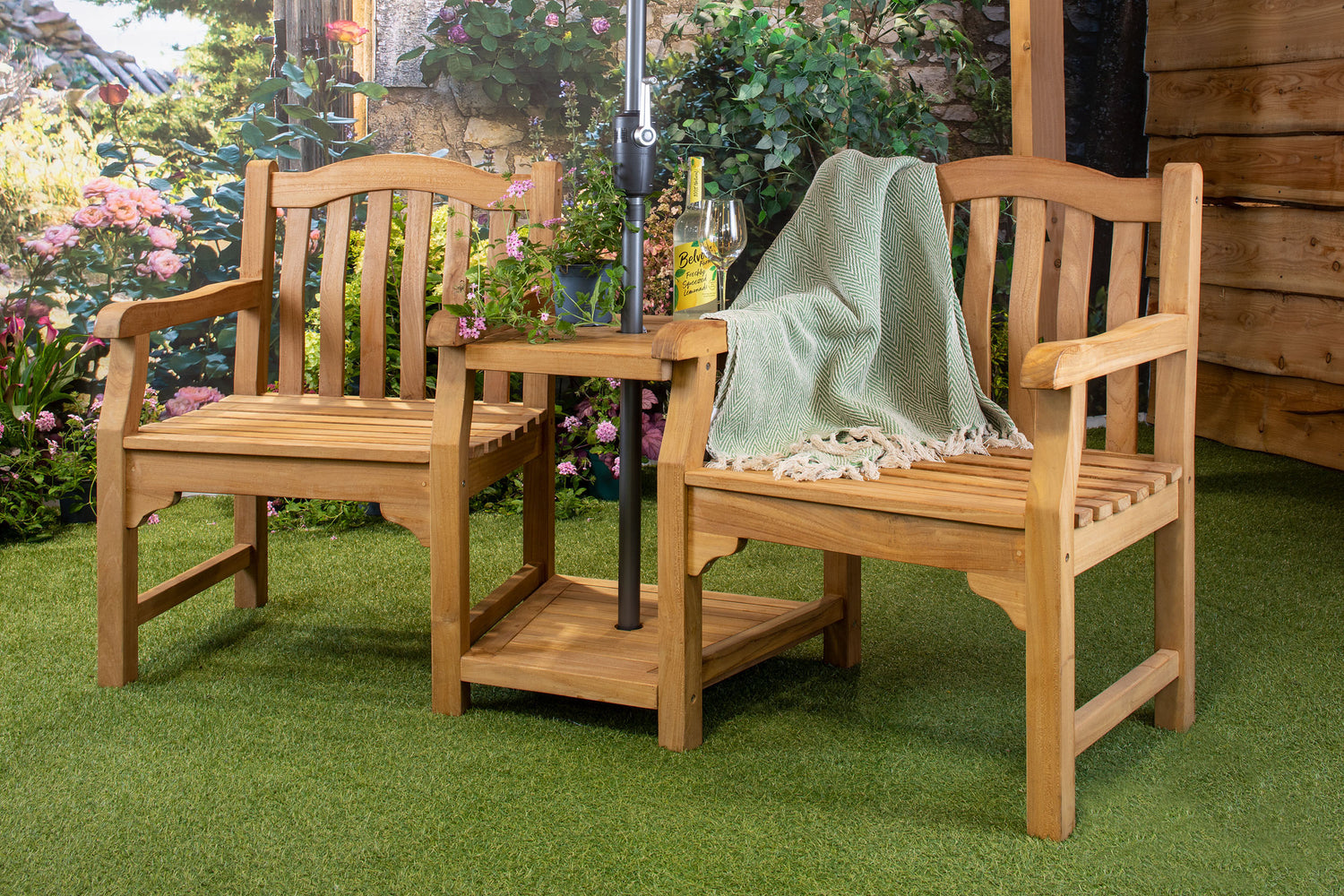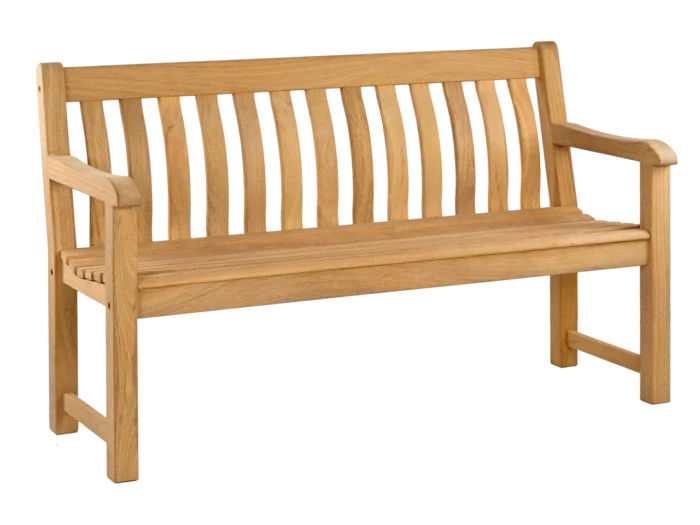Now's the time to update your outdoor space
- Create somewhere to sit in the sunshine and chill.
Now that you have a lot of time on your hands and the weather is looking good why not make a cosy place to sit, enjoy the sunshine and just chill out. Find a sheltered sunny spot and start by clearing away all the clutter or weed and cut the grass. If the wall or fence is looking a bit shabby give it a clean and a lick of paint or wood stain. Plant some climbing plants to soften the area, muffle the noise from the neighbours and give you a gorgeous relaxing aroma. Suggested plants are honeysuckle, roses, star jasmine, if you have a sunny sheltered spot or annual sweet peas, just make sure their roots are cool and shady and their heads are in the sun. If you love your own veg and the wall or fence is in full sun why not give tomatoes, cucumber, peas or beans a go. Plant up some containers to surround your seating area and give it a lush secluded feel.
Invest in some comfy good quality garden furniture, budget furniture soon looks shabby and won’t last very long. If the budget doesn’t allow for new furniture bring a rug outdoors along with a pile of large cushions and throws.
- Plant a container with summer bedding plants.
There’s nothing like a huge splash of colour for boosting your mood and planting a container of bright summer plants couldn’t be easier. Add instant colour to a drab back yard or doorway. The best thing about summer bedding is you don’t have to worry about it being colour co-ordinated as anything goes. Bedding packs are available quite cheaply in most supermarkets and some garden centres are doing a home delivery service. If you don’t have a container dig out some old wellies or boots, a bucket with a hole in the bottom or use a colander for a hanging basket. Compost with added fertiliser and water retention gel is available and ideal for tubs and baskets as you don’t need to feed them again until about the end of August and they will also need less watering. To keep them flowering remember to continually dead-head as this encourages them to continue flowering. Towards the end of summer feed weekly with a tomato fertiliser to encourage them to flower into the autumn.

- Plant up an herb container and learn some new recipes.
Most of us cook Mediterranean food and keeping a pot of fresh herbs in a sunny spot near the kitchen door or barbecue can elevate the mundane to the sublime, just add them at the last minute. Try oregano, thyme, basil, sage, rosemary and parsley all together in a container. They need good drainage so place a piece of crock over the hole in the bottom of the pot and fill with a free-draining compost such as John Innes No 1. You don’t need to feed the herbs as too much fertiliser will result in lush plants with very little flavour; the harder they are grown the stronger the flavour. Don’t over water just keep them damp and allow to dry out slightly before watering again.

Some herbs such as mint and horseradish need to be grown separately as they are real thugs and will soon strangle the slower growing herbs. Once you have your pot of fresh herbs why not try some different recipes to impress family and friends once we are all released back into the big wide world. Something as simple as sprigs of rosemary with lamb done ‘low and slow’ on the barbecue can produce an absolutely heavenly dish. Read the blog and watch the video showing how to cook minted lamb on the Traeger.
- Grow some salad leaves on a sunny windowsill.
You don’t necessarily need any outdoor space to grow a few tasty treats, all you need is a sunny windowsill. Collect the plastic fruit punnets from the supermarket and you don’t need to buy seed trays, all you need is a bit of seed compost and some mixed salad leaf seed. Three-quarters fill the punnet with seed compost, stand it in water for a few minutes until the compost is wet then sow the seed thinly over the surface. Cover with about 1mm of compost and thereafter just stand the punnet in water to keep it evenly damp, not sodden otherwise the seedlings will just rot. Sow a batch every 3 weeks and you will have a succession of tasty leaves. As well as leaves you can also grow herbs and chillies.
- Plant some toning perennials in a container.
If you want something a bit more stylish than a tub of bedding plants go instead for perennials. There is a huge amount of choice, if you have large enough tubs then trees and large shrubs are possible. If you want low maintenance then go for a Mediterranean palette of silver leaved plants paired with an olive tree or the tall thin Juniper ‘Blue Arrow’ for a touch of stately grandeur. Bamboo is a gorgeous plant to have in a large pot, you get the gentle rustle of the breeze in the leaves, a supply of garden canes and it will screen your patio from prying eyes. Succulents are another great group of plants which need hardly any maintenance and very little water.
- Plant a container of sweet peas.
Sweet peas are the absolute epitome of a beautiful English summer day; their scent is second to none and the great thing is the more you pick the more they keep on flowering. They like their roots cool and damp but their heads in the sun. If you are growing them in a container it must be at least 45 x 45cm (18” x 18”) wide and deep; use a moisture retentive compost and keep them well watered. Place other pots of plants around their container so that the sun doesn’t hit the side of the pot and mulch the top of the compost with a good layer of chipped bark, don’t use pebbles as these only conduct the heat down into the soil. Place 6 – 8 210cm (7’) canes around the edge of the container and tie them together at the top to form a wigwam. Once they have formed their first buds feed with a tomato fertiliser every week.

- Try growing some easy fruit and vegetables.
Recently the COVID crisis has seen a scarcity of some fruit and vegetables so why not have a go at growing some yourself; they are so much tastier and cheaper than supermarket produce. Don’t be put off by not having a garden as there are a lot of smaller varieties which can be grown in containers; strawberries, blueberries, dwarf beans, peas, radish, lettuce or potatoes are all easy to start off with if you don’t have any experience. Read the blog giving more details on what can be grown in a limited space.

- Tidy the garden and make a plan.
If you haven’t got a clue what you want from your outdoor space or how to create an enticing outdoor enteraining space just tidy what you have; mow the lawn, weed and dig over beds, clear the junk off the patio and then clean it down. Once you have your blank canvas ask yourself some questions:
- What are you going to use the space for; entertain family and friends? A show garden? Quintessential English cottage garden? Easy maintenance urban minimalist space? Grow your own veg? Do you need to make a separate area where the children can play safely?
- What sort of budget do you have?
- What are your skills; are you great at DIY or are you going to have to hire in labour?
- What is your time frame? If you want it instantly then you are maybe going to have to go down the expensive route and engage professionals.
- Do you want it to add value to your home or are you staying there long term?
Once you have the answers to these questions take a comfy chair outside along with your laptop, a drink and a good supply of nibbles and get researching.
- Grow a blueberry in a container.
Blueberries are expensive to buy in the supermarket and are quite often tasteless so grow your own in a container. You do get a crop off only one bush but they will crop more heavily if you have two. You must use an ericaceous compost, for acid loving plants, not just a general purpose compost. Don’t forget to keep them well watered and site in a sunny spot.

- Sow a patch of annuals.
If you have any bare patches of earth left in a sunny position once you have weeded and tidied try sowing some patches of annuals, they are an inexpensive way to add colour to your garden and as a bonus they provide cut flowers for the house. Just get a seed mixture and sow onto soil which has been raked finely and the stones removed. Once the seed is sown rake over lightly and water with a fine rose on your watering can to avoid washing the seed into clumps. At the end of the season leave a few flower heads to set seed, collect them into an envelope once they have dried and you need not buy more seed the following year.
- Plant a hanging basket of strawberries.
Even if you don’t have much outdoor space you can still have that sense of achievement quite easily by growing some strawberries in a hanging basket or an old colander if you don’t have a basket. Use the same compost that you would for summer bedding and make sure they don’t dry out. For full details read the blog and watch the video showing exactly how to do this.
- Decorate your space
Now that you’ve got your outdoor space sorted why not add some decorative touches to give your space a garden party feel. Chop up your old clothes and make some bunting, root out the Christmas tree lights (make sure they are for outdoors) and set the table for afternoon tea with a tablecloth and your prettiest china. Make scones, jelly with fresh fruit and dainty sandwiches then sit back and enjoy what free time you have left before joining the rat race again.




![Kingsbury-bench-05[1].jpg](http://www.hayesgardenworld.co.uk/cdn/shop/files/Kingsbury-bench-05_5B1_5D.jpg?v=1712162737&width=1500)
![Kingsbury-bench-01[1].jpg](http://www.hayesgardenworld.co.uk/cdn/shop/files/Kingsbury-bench-01_5B1_5D.jpg?v=1712161065&width=1500)
![tw17a-4947_0[1].jpg](http://www.hayesgardenworld.co.uk/cdn/shop/files/tw17a-4947_0_5B1_5D.jpg?v=1712161495&width=1500)
![tw17a-4947_tenbury_5ft[1].jpg](http://www.hayesgardenworld.co.uk/cdn/shop/files/tw17a-4947_tenbury_5ft_5B1_5D.jpg?v=1712161172&width=1500)
![tw17a-4952_tenbury_4ft[1].jpg](http://www.hayesgardenworld.co.uk/cdn/shop/files/tw17a-4952_tenbury_4ft_5B1_5D.jpg?v=1712161034&width=1500)
![thumbnail_IMG_1565-kik_2[1].jpg](http://www.hayesgardenworld.co.uk/cdn/shop/files/thumbnail_IMG_1565-kik_2_5B1_5D.jpg?v=1712226536&width=1500)
![thumbnail_IMG_1565-kik_1[3].jpg](http://www.hayesgardenworld.co.uk/cdn/shop/files/thumbnail_IMG_1565-kik_1_5B3_5D.jpg?v=1712159637&width=1500)



![WD-XgESA[1].jpeg](http://www.hayesgardenworld.co.uk/cdn/shop/files/WD-XgESA_5B1_5D.jpg?v=1712159609&width=1500)